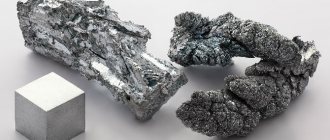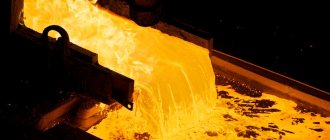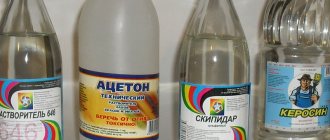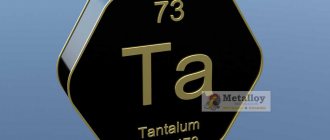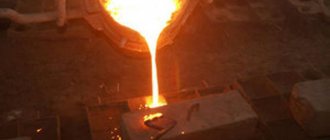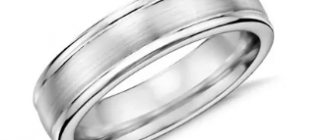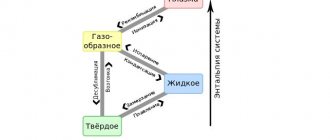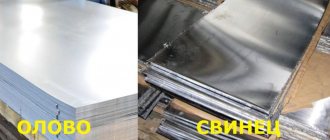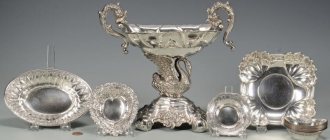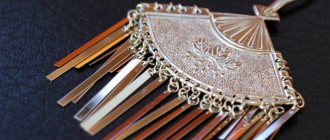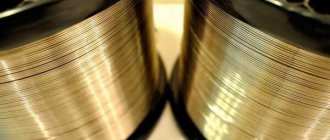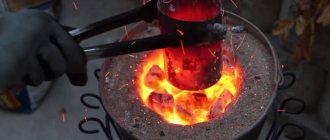TUNGSTEN
– (Wolframium), W – chemical element 6 (VIb) of the group of the periodic system of D.I. Mendeleev, atomic number 74, atomic weight 183.85.
There are 33 known isotopes of tungsten: from 158W to 190W. Five isotopes have been discovered in nature, three of which are stable: 180W (share among natural isotopes 0.120%), 182W (26.498%), 186W (28.426%), and the other two are weakly radioactive: 183W (14.314%, T½ = 1.1 ·1017 years), 184W (30.642%, T½ = 3·1017 years). The electron shell configuration is [Xe]4f145d46s2. The most typical oxidation state is +6. Known compounds have tungsten oxidation states +5, +4, +3, +2 and 0. Also on the topic:
CHEMISTRY
Back in the 14th–16th centuries. miners and metallurgists in the Ore Mountains of Saxony noted that some ores interfered with the reduction process of tinstone (cassiterite mineral, SnO2) and led to slagging of the molten metal. In the professional language of that time, this process was characterized as follows: “These ores tear out the tin and devour it, like a wolf devours a sheep.” The miners gave this “annoying” breed the names “Wolfert” and “Wolfrahm”, which translated means “wolf foam” or “foam in the mouth of an angry wolf.” German chemist and metallurgist Georg Agricola in his fundamental work Twelve Books on Metals
(1556) gives the Latin name for this mineral - Spuma Lupi, or Lupus spuma, which is essentially a tracing of the German folk name.
In 1779, Peter Wulf investigated the mineral now called wolframite (FeWO4 x
MnWO4), and came to the conclusion that it must contain a previously unknown substance. In 1783 in Spain, the d'Elhuyar brothers (Juan Jose and Fausto D'Elhuyar de Suvisa) using nitric acid isolated from this mineral “acid earth” - a yellow precipitate of an oxide of an unknown metal, soluble in ammonia water. Oxides of iron and manganese were also found in the mineral. Juan and Fausto calcined the “earth” with charcoal and obtained a metal, which they proposed to call “tungsten”, and the mineral itself – “wolframite”. Thus, the Spanish chemists d'Elguiar were the first to publish information about the discovery of a new element.
Later it became known that for the first time tungsten oxide was discovered not in the “tin eater” - wolframite, but in another mineral.
In 1758, Swedish chemist and mineralogist Axel Fredrik Cronstedt discovered and described an unusually heavy mineral (CaWO4, later named scheelite), which he named Tung Sten, which means “heavy stone” in Swedish. Kronstedt was convinced that this mineral contained a new, not yet discovered, element.
In 1781, the great Swedish chemist Karl Scheele decomposed the “heavy stone” with nitric acid, discovering, in addition to the calcium salt, “yellow earth”, which was not similar to the white “molybdenum earth”, which he had first isolated three years earlier. Interestingly, one of the d'Elguiar brothers worked in his laboratory at that time. Scheele named the metal "tungsten", after the name of the mineral from which the yellow oxide was first isolated. So the same element got two names.
In 1821, von Leonhard proposed calling the mineral CaWO4 scheelite.
The name tungsten can be found in Lomonosov; Soloviev and Hess (1824) call it thistle, Dvigubsky (1824) - tungsten.
Back at the beginning of the 20th century. in France, Italy and the Anglo-Saxon countries, the element “tungsten” was designated as Tu (from tungsten). It was only in the middle of the last century that the modern symbol W was established.
How was he found?
The history of the discovery is connected with the Swedish chemist K.V. Scheele. From an unstudied mineral, he isolated an unknown “tungsthenic” acid (WO3 H2O). The Eluard brothers isolated a new element from its salts. Since they worked with wolframite, the element was named tungsten.
Tungsten rods with crystalline growths
Biological role of tungsten
limited. Its neighbor in the group, molybdenum, is indispensable in enzymes that ensure the fixation of atmospheric nitrogen. Previously, tungsten was used in biochemical studies only as an antagonist of molybdenum, i.e. replacing molybdenum with tungsten in the active site of the enzyme led to its deactivation. On the contrary, enzymes that are deactivated when replacing tungsten with molybdenum are found in thermophilic microorganisms. Among them are formate dehydrogenases, aldehyde ferredoxin oxidoreductases; formaldehyde ferredo-xyn oxidoreductase; acetylene hydratase; carboxylic acid reductase. The structures of some of these enzymes, such as aldehyde ferredoxin oxidoreductase, have now been determined.
Severe consequences of exposure to tungsten and its compounds on humans have not been identified. Long-term exposure to large doses of tungsten dust can cause pneumoconiosis, a disease caused by all heavy powders entering the lungs. The most common symptoms of this syndrome are cough, breathing problems, atopic asthma, changes in the lungs, the manifestation of which decreases after cessation of contact with metal.
Yuri Krutyakov
Properties
Tungsten is a transition metal.
It has a silver-gray color. In the periodic table of Mendeleev it is located in group VI and has atomic number 74. Physical properties of the metal:
- density 19.25 g/cm3;
- crystal structure body-centered, cubic;
- paramagnetic;
- melting point 3422 °C;
- spark color - yellow, gives a bunch of short intermittent sparks;
- number of stable isotopes 4.
Some properties of tungsten are unique. Refractoriness is the hallmark of tungsten; it distinguishes it from other metals.
| Properties of the atom | |
| Name, symbol, number | Tungsten / Wolframium (W), 74 |
| Atomic mass (molar mass) | 183.84(1)[1] a. e.m. (g/mol) |
| Electronic configuration | [Xe] 4f14 5d4 6s2 |
| Atomic radius | 141 pm |
| Chemical properties | |
| Covalent radius | 170 pm |
| Ion radius | (+6e) 62 (+4e) 70 pm |
| Electronegativity | 2.3 (Pauling scale) |
| Electrode potential | W ← W3+ 0.11 V W ← W6+ 0.68 V |
| Oxidation states | 6, 5, 4, 3, 2, 0 |
| Ionization energy (first electron) | 769.7 (7.98) kJ/mol (eV) |
| Thermodynamic properties of a simple substance | |
| Density (at normal conditions) | 19.25[2] g/cm³ |
| Melting temperature | 3695 K (3422 °C, 6192 °F)[2] |
| Boiling temperature | 5828 K (5555 °C, 10031 °F)[2] |
| Ud. heat of fusion | 285.3 kJ/kg 52.31[3][4] kJ/mol |
| Ud. heat of vaporization | 4482 kJ/kg 824 kJ/mol |
| Molar heat capacity | 24.27[5] J/(K mol) |
| Molar volume | 9.53 cm³/mol |
| Crystal lattice of a simple substance | |
| Lattice structure | cubic body-centered |
| Lattice parameters | 3.160 Å |
| Debye temperature | 310K |
| Other characteristics | |
| Thermal conductivity | (300 K) 162.8[6] W/(m K) |
| CAS number | 7440-33-7 |
We recommend: ANTIMONY - from eye beauty to batteries
Not proven: there is an assumption that seaborgium (an isotope is unstable, its half-life is only 0.01 seconds) is more refractory.
Tungsten, properties of the atom, chemical and physical properties.
W 74 Tungsten
183.84(1) 1s2 2s2 2p6 3s2 3p6 3d10 4s2 4p6 4d10 4f14 5s2 5p6 5d4 6s2
Tungsten is an element of the periodic system of chemical elements of D.I. Mendeleev with atomic number 74. It is located in the 6th group (according to the old classification - a secondary subgroup of the sixth group), the sixth period of the periodic system.
Tungsten atom and molecule. Tungsten formula. Structure of tungsten
Isotopes and modifications of tungsten
Properties of tungsten (table): temperature, density, pressure, etc.
Physical properties of tungsten
Chemical properties of tungsten. Tungsten interaction. Reactions with tungsten
Production of tungsten
Applications of tungsten
Table of chemical elements D.I. Mendeleev
Deposits and production
Wolframites (Hübnerite, Ferberite) and scheelite are suitable for industrial mining.
Classification of deposits:
- stockwork wolframite;
- stockwork scheelite;
- vein wolframite;
- skarn-scheelite.
The largest reserves of tungsten ores are:
- China;
- Canada;
- Russia;
- Australia;
- USA.
Russian reserves of tungsten ores originate from primary deposits.
Being in nature
The tungsten Clarke of the earth's crust is (according to Vinogradov) 1.3 g/t (0.00013% of the content in the earth's crust). Its average content in rocks, g/t: ultrabasic - 0.1, basic - 0.7, intermediate - 1.2, acidic - 1.9.
Main article:
Tungsten ores
Tungsten occurs in nature mainly in the form of oxidized complex compounds formed by tungsten trioxide WO3 with oxides of iron and manganese or calcium, and sometimes lead, copper, thorium and rare earth elements. Wolframite (tungstate of iron and manganese n)
FeWO4
m
MnWO4 - ferberite and hübnerite, respectively) and scheelite (calcium tungstate CaWO4). Tungsten minerals are usually embedded in granite rocks, so the average tungsten concentration is 1-2%.
Place of Birth
Kazakhstan, China, Canada and the USA have the largest reserves; deposits are also known in Bolivia, Portugal, Russia, Uzbekistan and South Korea. World tungsten production is 49-50 thousand tons per year, including 41 in China, 3.5 in Russia; Kazakhstan 0.7, Austria 0.5. Main exporters of tungsten: China, South Korea, Austria. Main importers: USA, Japan, Germany, UK. There are also tungsten deposits in Armenia and other countries.
Receipt
The industrial production of metal from ore is preceded by enrichment. These are crushing, grinding, flotation. WO3 is then separated from the concentrate, which is then reduced to the metal with hydrogen at a temperature of about 700°C.
Compact tungsten is obtained:
- Using powder metallurgy method. The advantage of the method is the possibility of uniform introduction of additives.
- Electron beam melting, or melting in electric arc furnaces. The advantage of the method is the ability to obtain large (up to 3 tons) metal blanks.
Tungsten powder
Tungsten filament manufacturing technology and its history.
The production volumes of tungsten wire have a small share among all tungsten applications, but the development of the technology for its production played a key role in the development of powder metallurgy of refractory compounds.
Since 1878, when Swan demonstrated the eight- and sixteen-candle carbon lamps he had invented in Newcastle, a search had been going on for a more suitable material for making incandescent filaments. The first coal lamp had an efficiency of only 1 lumen/watt, which was increased over the next 20 years by modifications in coal processing methods by two and a half times. By 1898, the light output of such bulbs was 3 lumens/watt. In those days, carbon filaments were heated by passing an electric current in an atmosphere of heavy hydrocarbon vapors. During the pyrolysis of the latter, the resulting carbon filled the pores and irregularities of the thread, giving it a bright metallic shine.
At the end of the 19th century. von Welsbach was the first to produce metal filament for incandescent lamps. He made it from osmium (Tm = 2700° C). Osmium filaments had an efficiency of 6 lumens/watt, however, osmium is a rare and extremely expensive platinum group element, so it was not widely used in the manufacture of household devices. Tantalum, with a melting point of 2996° C, was widely used in the form of drawn wire from 1903 to 1911 thanks to the work of von Bolton of Siemens and Halske. The efficiency of tantalum lamps was 7 lumens/watt.
Tungsten began to be used in incandescent lamps in 1904 and replaced all other metals in this capacity by 1911. A conventional incandescent lamp with a tungsten filament has a glow of 12 lumens/watt, and lamps operating under high voltage - 22 lumens/watt. Modern tungsten cathode fluorescent lamps have an efficiency of about 50 lumens/watt.
In 1904, they tried to apply the wire drawing process developed for tantalum to more refractory metals such as tungsten and thorium. The rigidity and lack of malleability of tungsten did not allow the process to proceed smoothly. However, it was later shown in 1913–1914 that molten tungsten could be rolled out and drawn using a partial reduction procedure. An electric arc was passed between a tungsten rod and a partially molten tungsten droplet placed in a graphite crucible coated inside with tungsten powder and located in a hydrogen atmosphere. Thus, small drops of molten tungsten were obtained, about 10 mm in diameter and 20–30 mm in length. Although with difficulty, it was already possible to work with them.
During the same years, Just and Hannaman patented a process for making tungsten filaments. Fine metal powder was mixed with an organic binder, the resulting paste was passed through dies and heated in a special atmosphere to remove the binder, resulting in a thin thread of pure tungsten.
In 1906–1907 the well-known extrusion process was developed and used until the early 1910s. Very finely ground black tungsten powder was mixed with dextrin or starch until a plastic mass was formed. Using hydraulic pressure, this mass was forced through thin diamond sieves. The resulting thread was strong enough to be wound onto spools and dried. Next, the threads were cut into “pins,” which were heated in an inert gas atmosphere to a red-hot temperature to remove residual moisture and light hydrocarbons. Each “pin” was secured in a clamp and heated in a hydrogen atmosphere until it glowed brightly by passing an electric current. This led to the final removal of unwanted impurities. At high temperatures, individual small particles of tungsten fuse and form a homogeneous solid metal filament. These threads are elastic, although fragile.
At the beginning of the 20th century. Yust and Hannaman developed another process that was notable for its originality. A carbon filament with a diameter of 0.02 mm was coated with tungsten by heating in an atmosphere of hydrogen and tungsten hexachloride vapor. The thread coated in this way was heated to a bright glow in hydrogen at reduced pressure. In this case, the tungsten shell and the carbon core were completely fused with each other, forming tungsten carbide. The resulting thread was white and brittle. The filament was then heated in a stream of hydrogen, which reacted with the carbon, leaving a compact filament of pure tungsten. The threads had the same characteristics as those obtained during the extrusion process.
In 1909, the American Coolidge managed to obtain malleable tungsten without the use of fillers, but only with the help of reasonable temperature and mechanical processing. The main problem in producing tungsten wire was the rapid oxidation of tungsten at high temperatures and the presence of a grain structure in the resulting tungsten, which led to its brittleness.
Modern production of tungsten wire is a complex and precise technological process. The starting material is powdered tungsten obtained by reducing ammonium paratungstate.
Tungsten powder used for wire production must be of high purity. Typically, tungsten powders of different origins are mixed to homogenize the quality of the metal. They are mixed in mills and, to avoid oxidation of the metal heated by friction, a stream of nitrogen is passed into the chamber. The powder is then pressed in steel molds using hydraulic or pneumatic presses (5–25 kg/mm2). When contaminated powders are used, the compact becomes brittle and a fully oxidizable organic binder is added to eliminate this effect. At the next stage, preliminary sintering of the bars is carried out. When heating and cooling compacts in a hydrogen flow, their mechanical properties improve. The compacts still remain quite fragile, and their density is 60–70% of the density of tungsten, so the bars are subjected to high-temperature sintering. The rod is clamped between contacts cooled by water, and in an atmosphere of dry hydrogen, a current is passed through it to heat it almost to the melting point. Due to heating, tungsten is sintered and its density increases to 85–95% of the crystalline density, at the same time the grain sizes increase and tungsten crystals grow. This is followed by forging at high (1200–1500° C) temperatures. In a special apparatus, the rods are passed through a chamber, which is compressed with a hammer. During one pass, the diameter of the rod decreases by 12%. When forged, tungsten crystals elongate, creating a fibrillar structure. After forging, wire drawing follows. The rods are lubricated and passed through diamond or tungsten carbide screens. The degree of drawing depends on the purpose of the resulting products. The diameter of the resulting wire is about 13 microns.
Alloys
Additives change the characteristics of the resulting alloys.
| Brand of Russian alloy | Additives |
| VD-20 | 80% tungsten, 20% copper |
| Residence permit-95 | 3% nickel, 2% iron |
| VNM 2-1 | 2% nickel, 1% copper |
| Residence permit 7-3 | 7% nickel, 3% iron |
| VD-30 | 70% tungsten, 30% copper |
| Residence permit-97.5 | 1.5% nickel, 1% iron |
Advantages and disadvantages
The advantages are due to high performance:
• melting (very high temperature);
• strength (the leader among all existing metals);
• density;
• electrical conductivity.
In addition, tungsten is resistant to corrosion processes and has a low coefficient of thermal expansion.
The disadvantages of tungsten include fragility and the possibility of destruction upon impact.
Application
The metalworking, petrochemical, and furniture industries compete in the use of refractory metal.
Tungsten is used in the production of electrodes for argon-arc welding.
High-quality high-speed steel almost always contains tungsten.
The luminous filament in lighting lamps and the anodes and cathodes in electronic devices are pure tungsten.
Tungsten filaments
Pobedit, a famous Soviet alloy, consists of 90% tungsten carbide (WC). Pobedite drills are known to many “handicraft” men.
The metal is part of heavy alloys, which are used in the production of armor-piercing projectiles and gyroscopes for ballistic missiles.
We recommend: SILVER - lunar metal against any evil spirits
Jewelers have also begun to embrace heavy metal - it is hypoallergenic, heavy and durable.
For your information: tungsten and gold have almost the same densities. This was used by crooked craftsmen, “stuffing” gold bars with cheap tungsten.
WO3 nanoparticles have found application in medicine. Their antimicrobial properties are used for wastewater treatment. In computed tomography, WO3 nanoparticles are used as a contrast agent.
Processing of tungsten raw materials.
The primary ore contains about 0.5% tungsten oxide. After flotation and separation of non-magnetic components, a rock containing about 70% WO3 remains. The enriched ore (and oxidized tungsten scrap) is then leached with sodium carbonate or hydroxide:
4FeWO4 + O2 + 4Na2CO3 = 4NaWO4 + 2Fe2O3 + 4CO2
6MnWO4 + O2 + 6Na2CO3 = 6Na2WO4 + 2Mn3O4 + 6CO2
WO3 + Na2CO3 = Na2WO4 + CO2
WO3 + 2NaOH = Na2WO4 + H2O
Na2WO4 + CaCl2 = 2NaCl + CaWO4Ї.
The resulting solution is freed from mechanical impurities and then processed. Initially, calcium tungstate is precipitated, followed by its decomposition with hydrochloric acid and dissolution of the resulting WO3 in aqueous ammonia. Sometimes purification of primary sodium tungstate is carried out using ion exchange resins. The final product of the process is ammonium paratungstate:
CaWO4 + 2HCl = H2WO4Ї + CaCl2
H2WO4 = WO3 + H2O
WO3 + 2NH3·
H2O(conc.) = (NH4)2WO4 + H2O
12(NH4)2WO4 + 14HCl(highly diluted) = (NH4)10H2W12O42 + 14NH4Cl + 6H2O
Another way to separate tungsten from enriched ore is by treating it with chlorine or hydrogen chloride. This method is based on the relatively low boiling point of tungsten chlorides and oxochlorides (300 ° C). The method is used to obtain especially pure tungsten.
Wolframite concentrate can be fused directly with coal or coke in an electric arc chamber. This produces ferrotungsten, which is used in the manufacture of alloys in the steel industry. Pure scheelite concentrate can also be added to the steel melt.
About 30% of global tungsten consumption is achieved through the processing of secondary raw materials. Contaminated tungsten carbide scrap, shavings, sawdust and tungsten powder residues are oxidized and converted into ammonium paratungstate. Scrap of high-speed steels is utilized in the production of the same steels (up to 60–70% of the total melt). Tungsten scrap from incandescent lamps, electrodes and chemical reagents is practically not recycled.
The main intermediate product in the production of tungsten is ammonium paratungstate (NH4)10W12O41·
5H2O. It is also the main transported tungsten compound. By calcining ammonium paratungstate, tungsten(VI) oxide is obtained, which is then treated with hydrogen at 700–1000 ° C to obtain metal tungsten powder. By sintering it with carbon powder at 900–2200° C (carburization process), tungsten carbide is obtained.
In 2002, the price of ammonium paratungstate, the main commercial tungsten compound, was about $9,000 per ton in terms of metal. Recently, there has been a downward trend in prices for tungsten products due to large supply from China and the countries of the former USSR.
In Russia, tungsten products are produced by: Skopinsky Hydrometallurgical Plant (Ryazan region, tungsten concentrate and anhydride), Vladikavkazsky (North Ossetia, tungsten powder and ingots), Nalchik Hydrometallurgical Plant (Kabardino-Balkaria, metal tungsten, tungsten carbide), Kirovgrad Hard Alloy Plant (Sverdlovsk region, tungsten carbide, tungsten powder), Elektrostal (Moscow region, ammonium paratungstate, tungsten carbide), Chelyabinsk Electrometallurgical Plant (ferrotungsten).
Chemical properties[ | ]
It exhibits valency from 2 to 6. The most stable is 6-valent tungsten. 3- and 2-valent tungsten compounds are unstable and have no practical significance.
Tungsten has high corrosion resistance: at room temperature it does not change in air; at red heat temperatures it slowly oxidizes into tungsten (VI) oxide. Tungsten ranks immediately after hydrogen in the voltage series, and is almost insoluble in hydrochloric, dilute sulfuric and hydrofluoric acids. In nitric acid and aqua regia it oxidizes from the surface. Dissolves in hydrogen peroxide.
Easily dissolves in a mixture of nitric and hydrofluoric acids[10]:
2 W + 4 HNO 3 + 10 HF ⟶ WF 6 + WOF 4 + 4 NO ↑ + 7 H 2 O {\displaystyle {\mathsf {2W+4HNO_{3}+10HF\longrightarrow WF_{6}+WOF_{4} +4NO\uparrow +7H_{2}O}}}
Reacts with molten alkalis in the presence of oxidizing agents[11]:
2 W + 4 N a OH + 3 O 2 ⟶ 2 N a 2 WO 4 + 2 H 2 O {\displaystyle {\mathsf {2W+4NaOH+3O_{2}\longrightarrow 2Na_{2}WO_{4}+2H_ {2}O}}} W + 2 N a OH + 3 N a NO 3 ⟶ N a 2 WO 4 + 3 N a NO 2 + H 2 O {\displaystyle {\mathsf {W+2NaOH+3NaNO_{3} \longrightarrow Na_{2}WO_{4}+3NaNO_{2}+H_{2}O}}}
At first, these reactions proceed slowly, but when they reach 400 °C (500 °C for a reaction involving oxygen), tungsten begins to self-heat, and the reaction proceeds quite violently, producing a large amount of heat.
It dissolves in a mixture of nitric and hydrofluoric acid, forming hexafluorotungstic acid H2[WF6]. Of the tungsten compounds, the most important are: tungsten trioxide or tungsten anhydride, tungstates, peroxide compounds with the general formula Me2WOX, as well as compounds with halogens, sulfur and carbon. Tungstates are prone to the formation of polymer anions, including heteropolycompounds with the inclusion of other transition metals.
New technologies
1. Type A 2 (Tungsten structure)
The structural type of tungsten (type of bcc metals) includes refractory metals: chromium, vanadium, molybdenum, niobium, tantalum, cobalt, iron, titanium, zirconium, hafnium, alkali elements - lithium, sodium, potassium, rubidium, cesium, alkaline earth - calcium, strontium, barium, actinides - uranium, neptunium, plutonium. AgZn, Cu3Al, CoAl, Cu5Sn, LiAg, LiAl, TaH, etc. crystallize from intermetallic compounds in the bcc structure.
In a body-centered cubic tungsten cell, the atoms are located at the vertices and in the center of the cell, i.e. There are two atoms per cell. The bcc structure is not the closest packing of atoms. The compactness coefficient is 0.68. Tungsten space group Im3m.
2. A cubic body-centered lattice is characteristic of refractory metals. a =1.21·d. 1/8 8 +1 =2. Feα, Ti, W, Nb.
3. In the unit cell of a cubic body-centered lattice (Fig. A)
contains nine atoms: eight are located at the nodes of the cell and one atom is in the center. This type of lattice is found in lithium, sodium, potassium, rubidium, vanadium, molybdenum, tungsten, niobium, tantalum, iron and other metals.
TUNGSTEN
[from German Wolf - wolf, Rahm - cream (“wolf foam” - the name was given in the 16th century, because it interfered with the smelting of tin, turning it into slag); lat. Wolframium] W, chem. element VI gr. periodic systems, at. n. 74, at. m. 183.85. Nature V. consists of five stable isotopes with wt. Part 180 (0.135%), 182 (26.41%), 183 (14.4%), 184 (30.64%) and 186 (28.41%). The cross-section of thermal neutron capture is 19.2*10-28 m2. External configuration electron shell 5d46s2; oxidation state +2; +3, +4, +5, +6 (most common); ionization energy W° -> W+ -> W2+ resp. 770 and 1710 kJ/mol; Pauling electronegativity 1.7; electron affinity 0.5 eV; electron work function 4.55 eV; electron emission (mA/cm2): 1.5*10-10 (1100 K), 2.3*10-1 (1900 K), 298 (2500 K); at. radius 0.1368 nm; ionic radii (coordination numbers are indicated in parentheses) W4 + 0.080 nm (6), W6 + 0.065 nm (4), 0.074 nm (6). V. is not widespread in nature. The content in the earth's crust is 1*10-4% by weight. Known approx. 15 own minerals, most of them are tungstates. max. important minerals are wolframite (Fe, Mn)WO4 [its varieties are ferberite (Fe: Mn > 4:1) and hübnerite (Mn: Fe > 4:1)] and scheelite CaWO4. max. large industrial deposits in China, USSR, North Korea, South Korea, USA, Thailand, Canada, Bolivia, Australia, Brazil, Portugal. World reserves of V. in ores are 1815 thousand tons (1976). Properties. V. is a light gray metal. Basic stable modification-W, body-centered grid. cubic (a = 0.31589 nm, z = 2, space group Im3m). There is also a modification with a cube. crystalline lattice (z = 8, space group Pm3n); is formed when a thin layer of WO3 is reduced with dry H2 at 440-630 °C; above 630°C irreversibly transforms. inW. V. is the most refractory metal, m.p. 3380+10 °C, bp. 5900-6000°C; dense 19.3 g/cm3, liquid 16.65 g/cm3; С° 24.27 J/(mol*K); 46 kJ/mol, 850 kJ/mol (O K); So298 32.6 J/(mol*K); level of temperature dependence of vapor pressure over solid water in the range of 2000-3500 K: log p (mm Hg) = 42000/G + 9.84 -— 0.146T-lg T - 0.164 * 10-3T; evaporation rate [in g/(cm2*s)1 2.18*10-12 (2200 K), 1.06*10-6 (3000 K), 2.06 x 10-5 (3273 K); temperature coefficient linear expansion (K-1): 4.1*10-6 (298 K), 6.5*10-6 (2273 K), 7.1*10-6 (2673 K); thermal conductivity [W/(m*K)]: 153 (298 K), 105 (1873 K); thermal diffusivity (m2/s): 3.17*103 (1873 K), 2.3*103 (2873 K); Emissivity (W/cm2): 23.65 (2200 K), 112.5 (2800 K), 203 (3200 K); (Ohm*m): 5.5*10-8 (298 K), 55.7*10-8 (2000 K), 108.5*10-8 (2500 K); temperature coefficient 5.0*10-3 K -1 (273 - 473 K); temperature of transition to the superconducting state 0.0160 K. V. paramagnetic, magnetic. susceptibility 0.32*10-9. Fur. The properties of V. strongly depend on the method of its preparation, purity and previous fur. and thermal processing. Tech. V. is brittle at normal temperature, at 200-500°C it turns into a plastic state; high-purity monocrystalline V. is plastic up to -196 °C. Brinell hardness for a sintered bar is 2000-2300 MPa, for a sheet of thickness. 2 mm 3500-4000 MPa; for wire, the elastic modulus is 380-410 GPa (298 K); depending on the diameter, for unannealed wire 1800-4150 MPa, for annealed wire 900-1300 MPa. Coef. V.'s compressibility is lower than that of all metals. In terms of durability at 800-1300 °C, it is significantly superior to Mo, Ta and Nb. Compact V. is stable in air, at 400 °C it begins to oxidize, and above 500 °C it quickly oxidizes to WO3 trioxide (see Tungsten oxides). It does not interact with cold and hot water; water vapor above 600 °C oxidizes to WO3, WO2 and other oxides. In the cold, it is resistant to the action of hydrochloric acid, H2SO4, HNO3, as well as a mixture of HNO3 and H2SO4, actively interacting. with a mixture of HNO3 and HF, slowly - with H2O2. At 90-100 °C, it is resistant to the action of hydrofluoric acid, weakly interacting. with hydrochloric acid, H2SO4 and H2CrO4, somewhat stronger - with HNO3 and aqua regia. Not interaction. with solutions of alkalis and NH3 in the cold, reacts weakly with them when heated. in presence O2. Rapidly oxidizes in molten NaOH or KOH with access to air or in the presence. oxidizing agents (NaNO3, NaNO2, etc.) with the formation of tungstates. V. reacts with nitrogen above 1500°C; at 2300-2500 °C nitride WN2 is formed, which in the absence of N2 decomposes above 800 °C. Hydrogen does not react with hydrogen up to the melting point. O2 (less than 10-4% by weight), N2 (~ 10-5%) and H2 (less than 10-4%) are slightly soluble in V., with F2 above 150°C V. forms fluorides (see Tungsten hexafluoride) , with C12 above 800°C - chlorides, with Br2 and I2 at 600-700°C - respectively. bromides and iodides (see tungsten halides). With S and Se vapors, as well as with H2S and H2Se above 400 °C, it forms, respectively. disulfide WS2 (see Tungsten sulfides) and diselenide WSe2, with silicon and boron above 1400°C - respectively. silicides (WSi2 and W5Si3) and borides (W2B, WB, W2B5, etc.). At 700-800 °C, SO2 oxidizes V. to oxides, CO2 above 1200 °C - to WO2, N oxides above 600 °C - to WO3. Interaction V. with hydrocarbons at 1100-1200 °C leads to carbides. Up to ~ 1400°C, V. is stable in a CO atmosphere; at higher temperatures, tungsten carbides are formed. At 200-300 °C and a CO pressure of 20 MPa, V. (in an excited state) forms hexacarbonyl W (CO)6 with CO - colorless. crystals; m.p. 169°C, bp. 175°C; not sol. in water; above 350°С it decomposes into W and CO; used as a catalyst for the polymerization of olefins, for applying tungsten coatings to metals, ceramics, graphite, for the synthesis of tungsten. conn. (see also Metal carbonyls). V. very slow interaction. with Hg, Na, K, Ga, Mg even at 600 °C. It is stable at 600°C in Wood's alloy (see Lead alloys), at 1000°C in eutectic. Na-K alloy, up to 1680°C does not react with molten Bi, Ca, Cu and Sn. At 1100oC V. slowly dissolves. in U, above 700 °C it reacts with liquid Al, giving intermetallic compounds. V. is capable of forming alloys with many. metals (see tungsten alloys). The most important oxygen compounds. B. - WO3, tungsten compound WO3*H2O and its salts (tungstates). Polytungstates are known - salts of high molecular weight. isopoly- and aquapolyacids, as well as heteropolytungstates - salts of heteropolytungsten compounds (see Heteropolycompounds). When reducing alkali metal tungstates, crystalline tungsten bronzes are obtained. in-va with metallic. St. you (see Oxide bronzes). Tungsten diselenide WSe2 is a dark gray hexagonal crystal. lattice (a = 0.3280 nm, c = 1.2950 nm, space group p63/mmc); above 550 °C it oxidizes in air to WO3; in a vacuum above 900 °C it dissociates into W and Se. Not sol. in water; no interaction with dil. HC1, H2SO4, alkali solutions. Oxidized by HNO3. Receive interaction. vapors of Se or H2Se with W or WO3 at 600-800 °C. p-type semiconductor; used as a solid lubricant. Tungsten disilicide WSi2 - bluish-gray crystals with tetragons. grating (a = 0.3212 nm, c = 0.7880 nm, z = 2, space group I4/mmm); m.p. 2165 °C; dense 9.25 g/cm3; — 93.7 kJ/mol; 12.5*10-8 Ohm*m; 1269 MPa (20°C); microhardness 10740 MPa (load 50 g). Not sol. in water; no interaction with non-org. to-tami (except for hydrofluoric to-you). Receive: interaction. Si vapors with W in vacuum at 1150-1350 °C; reduction of SiCl4 with hydrogen on a W surface heated to 1100-1800°C; according to the distribution 4SiCl2 + + W WSi2 + 2SiCl4. Forms protective coatings on V products that are resistant in air up to 2000 °C. Tungsten boride (ditungsten pentaboride) W2B5 - gray crystals with metallic. gloss, hexagonal lattice (=W2B5; a = 0.292 nm, c = 1.387 nm, space, group C6/mmc); m.p. 2300 °C (with decomposition); dense 13.0 g/cm3; microhardness 25800 MPa; oxidizes in air above 800°C. Not sol. in water. Decomposes with aqua regia, as well as HNO3 and conc. H2SO4 at boiling. Receive interaction. WO3 with B4C and C in vacuum at 1150-1300 °C. Component of hard alloys for cutting tools, surfacing wear-resistant materials for steel and cast iron; forms protective coatings on B. Preparation. Tungsten ores (contain 0.15-0.5% WO3) are enriched by gravity methods, flotation, magnesium. and electrostatic separation, as well as chemical ways. To obtain V. and its connection. use ore concentrates containing 55-65% WO3, sometimes 10-20%, sent to the chemical. processing. Prom. Methods for extracting minerals from ore concentrates are divided into alkaline (the most common) and acidic. In the first case, wolframite or scheelite concentrate is decomposed by sintering with Na2CO3 at 800-900 °C, followed by by leaching the cake with water or treating it with Na2CO3 solution in an autoclave at 200-225 °C. Wolframite concentrates are sometimes decomposed by heating with NaOH solutions. For complete decomposition of wolframite by sintering, a small excess of Na2CO3 is required compared to the stoichiometrically required amount; in the case of scheelite, SiO2 is added to the charge (2CaWO4 + 2Na2CO3 + SiO2 -> 2Na2WO4 + + Ca2SiO4 + 2CO2). For complete decomposition of scheelite concentrates in an autoclave, the excess of Na2CO3 should be 250-300%, and in the case of wolframite concentrates - 300-400%. From the resulting aqueous solutions of Na2WO4, after they have been purified from impurities (Si, P, As, Mo, F) by the action of CaC12 or Ca(NO3)2, CaWO4 is precipitated, which is then decomposed with hydrochloric acid or HNO3 and tungsten acid is isolated that. The latter is calcined to obtain WO3, or dissolved in an aqueous solution of NH3, from which paratungstate (NH4)10[H2W12O42]*4H2O is crystallized by evaporation. This is the connection. m.b. also obtained in a simpler way - by extraction with aqueous solutions of amine salts or quaternary ammonium compounds. (at pH 2.5-3) with the following. re-extraction with NH3 solutions. A promising method for its production from Na2WO4 solutions using ion exchange resins. According to the acid method, scheelite concentrates (with a WO3 content of 65-75%) are decomposed by acids (HC1, HNO3); the resulting tungsten solution. in aqueous solution of NH3 and then crystallizes in the form of ammonium paratungstate. Basic products of processing of tungsten concentrates - WO3 (obtained by thermal decomposition of W03-H20 or (NH4)10[H2W12042] * 4H20) and ferrotungsten [an alloy of W (65-80%) and Fe (35-20%), smelted for the needs of ferrous metallurgy ]. By reducing WO3 with hydrogen at 700-900 °C in multi-pipe or rotary tubular furnaces, V. is obtained in the form of decomposed powder. granulometric composition (most likely, powders with an average particle size of 2-3 microns are typical). Basic impurity in powders is oxygen (0.05-0.3%). V. powders with additives of Th, La, Y, Al, and also K2SiO3 oxides are also obtained, which are introduced into WO3 before its reduction. Compact metal is preferred. powder metallurgy methods. Blanks with a cross section from 10*10 to 20*20 mm and a length of 500-600 mm (stubs) are pressed under pressure. 150-500 MPa and subjected to sintering in two stages: the first (strengthening of the rod) is carried out at 1150-1300 °C in an H2 atmosphere, the second (welding) is carried out by direct transmission of electricity. current at 2900-3000 °C. The density of the bars after sintering is 17.5-18.5 g/cm3. Products from them (wire, tape, etc.) are manufactured by pressure treatment at temperatures below the recrystallization temperature B. As processing proceeds, the temperature decreases from 1300-1400 °C (during forging) to 800-500 °C (at drawing or rolling). As a result of drawing through carbide and then diamond dies, tungsten wire with a diameter of 10-300 microns is obtained. Large workpieces (up to 300 kg) are produced using the hydrostatic method. pressing powders placed in elastic shells. Such blanks are sintered in induction furnaces in a vacuum or in an H2 atmosphere at 2400-2500 °C. To obtain compact workpieces, vacuum arc melting or scull arc melting with metal pouring into a mold is also used. In limited scales, V. is obtained by the reduction of its hexahalides, Ch. arr. WF6, hydrogen. When carrying out the process in the gas phase, highly dispersed powders are obtained in the flow, and large spherical ones are obtained in the fluidized bed. granules 200-500 microns in size. The latter are converted into compact blanks using hot gasostatic. pressing. The method of producing products by reducing WF6 (called gas-phase molding) involves deposition of metal from the gas phase in the form of a dense coating on substrates made of other metals or graphite heated to 600-700 °C. By the method of crucibleless zone melting of sintered rods, V. single crystals are obtained, characterized by high purity and ductility. Definition. V. is determined qualitatively: by the release of a white amorphous precipitate WO3*nH2O when HC1 or H2SO4 is added to the sample solution; by the formation of tungsten blue when SnCl2 is added to an acidic solution of the sample; according to the yellow-green color of the solution in the presence. thiocyanate ion and reducing agent (for example, SnCl2) and other methods. With a high content in the analyzed sample (concentrates, ferrotungsten, etc.), V. is determined gravimetrically in the form of WO3 (formed after calcination of tungsten acid or sediments released during the action, for example, cinchonine, benzindine, etc.), as well as potentiometrically . titration with Cr+ salt in an acidic medium. At low V. content, predominance is determined. photometrically according to the solution with thiocyanate ions present. TiCl3. To transfer V. into solution, the original sample is decomposed with hydrochloric or nitrogen solution, the precipitate WO3*nH2O sol. in aqueous solution NH3; Sometimes leaching of soda melt with water is used. Application. Up to 50% of the resulting vitreous is used in the production of alloyed (mainly tool) steels, the most important of which are high-speed steels containing 8-20% vitreous. Approximately 35-45% of vitreous steel is spent on the production of hard alloys based on WC carbide (85-95% WC and 5-15% Co). Some alloys, in addition to WC, contain TiC, TaC and NbC. These alloys are used for the manufacture of working parts of cutting and drilling tools, dies for drawing wire, etc. In the form of alloys with other metals, V. is used in aviation. and rocketry, electrical engineering; pure V. - for the manufacture of spirals and filaments in the production of electric lamps, in electric vacuum technology for the manufacture of cathodes, X-ray tubes, grids, cathode heaters, high voltage rectifiers, etc. Artificial radioactive isotopes V. 181W (T1/2 120 days), 185W (T1/2 78.5 days) and 187W (T1/2 24 hours) - isotope indicators. Production of tungsten concentrates (65% WO3) in capitalist. countries 39,400 t/year (1978), incl. in the USA 6300, Thailand 6200, Bolivia 6100, South Korea 5000, Australia 5300, Canada 4400, Brazil 2200, Portugal 2100 t/year. V. discovered in the form of WO3 by K. Scheele in 1781. Metallic. V. was first received by XX and F. dEluyar in 1873. In Great Britain, the USA and France, the original name of V. is used - “tangsten” (Tungsten, Swedish tungsten, lit. - heavy stone). Lit.: Zelikman A. N., Krein O. E., Samsonov G. V., Metallurgy of rare metals, 3rd ed., M., 1978; Zelikman A. N., Nikitina L. S., Wolfram, M., 1978; Rollinson S. Pergamon textes in inorganic chemistry, v. 21-The chemistry of Cr, Mo and W, Oxf.-[ao]. 1973; YihS.WH, WangC.T., Tungsten, NY, 1978; Gmelins Handbuch der anorganischen Chemie. Wolfram, Bd A. 1, Technologic des Metals, V., 1979. A. N. Zelikman.
Tungsten reserves in various countries
The largest tungsten resources are found in Russia, Canada and China. According to scientists' forecasts, about 943 thousand tons of this metal are located in domestic territories. If we believe these estimates, the vast majority of reserves are located in Southern Siberia and the Far East. The share of explored resources is very small - it is only about 7%.
In terms of the number of explored tungsten deposits, Russia is second only to China. Most of them are located in the regions of Kabardino-Balkaria and Buryatia. But in these deposits it is not pure tungsten that is mined, but its ores, which also contain molybdenum, gold, bismuth, tellurium, scandium and other substances. Two-thirds of the volumes of tungsten obtained from explored sources are contained in difficult-to-process ores, where the main tungsten-containing mineral is scheelite. The share of easily processed ores accounts for only a third of all production. The characteristics of tungsten mined in Russia are lower than abroad. The ores contain a large percentage of tungsten trioxide. There are very few placer metal deposits in Russia. Tungsten sands are also low quality, with a lot of oxides.
Excerpt characterizing Tungsten
Meanwhile, the city itself was empty. There was almost no one on the streets. The gates and shops were all locked; here and there near the taverns lonely screams or drunken singing could be heard. No one drove along the streets, and pedestrian footsteps were rarely heard. On Povarskaya it was completely quiet and deserted. In the huge courtyard of the Rostovs' house there were scraps of hay and droppings from a transport train, and not a single person was visible. In the Rostov house, which was left with all its good things, two people were in the large living room. These were the janitor Ignat and the Cossack Mishka, Vasilich’s grandson, who remained in Moscow with his grandfather. Mishka opened the clavichord and played it with one finger. The janitor, arms akimbo and smiling joyfully, stood in front of a large mirror. - That’s clever! A? Uncle Ignat! - the boy said, suddenly starting to clap the keys with both hands. - Look! - Ignat answered, marveling at how his face smiled more and more in the mirror. - Shameless! Really, shameless! – the voice of Mavra Kuzminishna, who quietly entered, spoke from behind them. - Eka, thick-horned, he bares his teeth. Take you on this! Everything there is not tidy, Vasilich is knocked off his feet. Give it time! Ignat, adjusting his belt, stopped smiling and submissively lowered his eyes, walked out of the room. “Auntie, I’ll go easy,” said the boy. - I'll give you a light one. Little shooter! – Mavra Kuzminishna shouted, raising her hand at him. - Go and set up a samovar for grandfather. Mavra Kuzminishna, brushing off the dust, closed the clavichord and, sighing heavily, left the living room and locked the front door. Coming out into the courtyard, Mavra Kuzminishna thought about where she should go now: should she drink tea in Vasilich’s outbuilding or tidy up what had not yet been tidied up in the pantry? Quick steps were heard in the quiet street. The steps stopped at the gate; the latch began to knock under the hand that was trying to unlock it. Mavra Kuzminishna approached the gate. - Who do you need? - Count, Count Ilya Andreich Rostov. - Who are you? - I'm an officer. “I would like to see,” said the Russian pleasant and lordly voice. Mavra Kuzminishna unlocked the gate. And a round-faced officer, about eighteen years old, with a face similar to the Rostovs, entered the courtyard. - We left, father. “We deigned to leave at vespers yesterday,” Mavra Kuzmipishna said affectionately. The young officer, standing at the gate, as if hesitant to enter or not to enter, clicked his tongue. “Oh, what a shame!..” he said. - Yesterday I wish... Oh, how sorry!.. Mavra Kuzminishna, meanwhile, carefully and sympathetically examined the familiar features of the Rostov breed in the face of the young man, and the tattered overcoat, and the worn-out boots that he was wearing. - Why did you need a count? – she asked. - Yeah... what to do! - the officer said with annoyance and grabbed the gate, as if intending to leave. He stopped again, undecided. – Do you see? - he suddenly said. “I am a relative of the count, and he has always been very kind to me.” So, you see (he looked at his cloak and boots with a kind and cheerful smile), and he was worn out, and there was no money; so I wanted to ask the count... Mavra Kuzminishna did not let him finish. - You should wait a minute, father. Just a minute,” she said. And as soon as the officer released his hand from the gate, Mavra Kuzminishna turned and with a quick old woman’s step walked into the backyard to her outbuilding. While Mavra Kuzminishna was running to her place, the officer, with his head down and looking at his torn boots, smiling slightly, walked around the yard. “What a pity that I didn’t find my uncle. What a nice old lady! Where did she run? And how can I find out which streets are the closest to catch up with the regiment, which should now approach Rogozhskaya? - the young officer thought at this time. Mavra Kuzminishna, with a frightened and at the same time determined face, carrying a folded checkered handkerchief in her hands, came out from around the corner. Without walking a few steps, she unfolded the handkerchief, took out a white twenty-five-ruble note from it and hastily gave it to the officer. “If their Lordships were at home, it would be known, they would definitely be related, but maybe... now...” Mavra Kuzminishna became shy and confused. But the officer, without refusing and without haste, took the piece of paper and thanked Mavra Kuzminishna. “As if the count were at home,” Mavra Kuzminishna kept saying apologetically. - Christ is with you, father! God bless you,” said Mavra Kuzminishna, bowing and seeing him off. The officer, as if laughing at himself, smiling and shaking his head, almost at a trot ran through the empty streets to catch up with his regiment to the Yauzsky Bridge. And Mavra Kuzminishna stood for a long time with wet eyes in front of the closed gate, thoughtfully shaking her head and feeling an unexpected surge of maternal tenderness and pity for the officer unknown to her. In the unfinished house on Varvarka, below which there was a drinking house, drunken screams and songs were heard. About ten factory workers were sitting on benches near tables in a small dirty room. All of them, drunk, sweaty, with dull eyes, straining and opening their mouths wide, sang some kind of song. They sang separately, with difficulty, with effort, obviously not because they wanted to sing, but only to prove that they were drunk and partying. One of them, a tall, blond fellow in a clear blue scent, stood above them. His face with a thin, straight nose would be beautiful if it were not for his thin, pursed, constantly moving lips and dull, frowning, motionless eyes. He stood over those who were singing, and, apparently imagining something, solemnly and angularly waved his white hand rolled up to the elbow over their heads, the dirty fingers of which he unnaturally tried to spread out. The sleeve of his tunic was constantly falling down, and the fellow diligently rolled it up again with his left hand, as if there was something particularly important in the fact that this white, sinewy, waving arm was certainly bare. In the middle of the song, screams of fighting and blows were heard in the hallway and on the porch. The tall fellow waved his hand. - Sabbath! – he shouted imperiously. - Fight, guys! - And he, without ceasing to roll up his sleeve, went out onto the porch. The factory workers followed him. The factory workers, who were drinking in the tavern that morning under the leadership of a tall fellow, brought skins from the factory to the kisser, and for this they were given wine. The blacksmiths from the neighboring cousins, hearing the noise in the tavern and believing that the tavern was broken, wanted to force their way into it. A fight broke out on the porch. The kisser was fighting with the blacksmith at the door, and while the factory workers were coming out, the blacksmith broke away from the kisser and fell face down on the pavement. Another blacksmith was rushing through the door, leaning on the kisser with his chest. The guy with his sleeve rolled up hit the blacksmith in the face as he was rushing through the door and shouted wildly: “Guys!” They're beating our people! At this time, the first blacksmith rose from the ground and, scratching the blood on his broken face, shouted in a crying voice: “Guard!” Killed!.. Killed a man! Brothers!.. - Oh, fathers, they killed him to death, they killed a man! - the woman squealed as she came out of the neighboring gate. A crowd of people gathered around the bloody blacksmith. “It’s not enough that you robbed people, took off their shirts,” said someone’s voice, turning to the kisser, “why did you kill a person?” Robber! The tall fellow, standing on the porch, looked with dull eyes first at the kisser, then at the blacksmiths, as if wondering who he should fight with now. - Murderer! – he suddenly shouted at the kisser. - Knit it, guys! - Why, I tied up one such and such! - the kisser shouted, waving off the people who attacked him, and, tearing off his hat, he threw it on the ground. As if this action had some mysteriously threatening significance, the factory workers who surrounded the kisser stopped in indecision. “Brother, I know the order very well.” I'll get to the private part. Do you think I won't make it? Nowadays no one is ordered to commit robbery! – the kisser shouted, raising his hat. - And let's go, look! And let's go... look! - the kisser and the tall fellow repeated one after another, and both moved forward along the street together. The bloody blacksmith walked next to them. Factory workers and strangers followed them, talking and shouting. At the corner of Maroseyka, opposite a large house with locked shutters, on which there was a sign of a shoemaker, stood with sad faces about twenty shoemakers, thin, exhausted people in dressing gowns and tattered tunics. - He will treat the people properly! - said a thin craftsman with a scraggly beard and frowning eyebrows. - Well, he sucked our blood - and that’s it. He drove us and drove us - all week. And now he brought it to the last end, and left. Seeing the people and the bloody man, the worker who had been speaking fell silent, and all the shoemakers, with hasty curiosity, joined the moving crowd. -Where are the people going? - It is known where, he goes to the authorities. - Well, did our power really not take over? - And you thought how! Look what the people are saying. Questions and answers were heard. The kisser, taking advantage of the increase in the crowd, fell behind the people and returned to his tavern. The tall fellow, not noticing the disappearance of his enemy the kisser, waving his bare arm, did not stop talking, thereby drawing everyone’s attention to himself. The people mostly pressed on him, expecting from him to get a solution to all the questions that occupied them. - Show him order, show him the law, that’s what the authorities are in charge of! Is that what I say, Orthodox? - said the tall fellow, smiling slightly. – He thinks, and there are no authorities? Is it possible without bosses? Otherwise, you never know how to rob them. - What nonsense to say! - responded in the crowd. - Well, then they’ll abandon Moscow! They told you to laugh, but you believed it. You never know how many of our troops are coming. So they let him in! That's what the authorities do. “Listen to what the people are saying,” they said, pointing to the tall fellow. Near the wall of China City, another small group of people surrounded a man in a frieze overcoat holding a paper in his hands. - The decree, the decree is being read! The decree is being read! - was heard in the crowd, and people rushed to the reader. A man in a frieze overcoat was reading a poster dated August 31st. When the crowd surrounded him, he seemed embarrassed, but in response to the demand of the tall fellow who had pushed ahead of him, with a slight trembling in his voice, he began to read the poster from the beginning. “Tomorrow I’m going early to the Most Serene Prince,” he read (the brightening one! - the tall fellow solemnly repeated, smiling with his mouth and frowning his eyebrows), “to talk with him, act and help the troops exterminate the villains; We too will become the spirit of them...” the reader continued and stopped (“Saw?” the little one shouted victoriously. “He will untie you all the distance...”) ... - to eradicate and send these guests to hell; I’ll come back for lunch, and we’ll get down to business, we’ll do it, we’ll finish it, and we’ll get rid of the villains.” The last words were read by the reader in complete silence. The tall fellow sadly lowered his head. It was obvious that no one understood these last words. In particular, the words: “I will come tomorrow for lunch,” apparently even upset both the reader and the listeners. The understanding of the people was in a high mood, and this was too simple and unnecessary understandable; this was the very thing that each of them could say and that therefore a decree emanating from a higher power could not speak. Everyone stood in dejected silence. The tall fellow moved his lips and staggered. “I should ask him!.. That’s what he is?.. Well, he asked!.. But then... He’ll point out...” was suddenly heard in the back rows of the crowd, and everyone’s attention turned to the droshky of the police chief, accompanied by two mounted dragoons. The police chief, who had gone that morning by order of the count to burn the barges and, on the occasion of this order, had rescued a large sum of money that was in his pocket at that moment, seeing a crowd of people moving towards him, ordered the coachman to stop. - What kind of people? - he shouted at the people, scattered and timidly approaching the droshky. - What kind of people? I'm asking you? - repeated the police chief, who did not receive an answer. “They, your honor,” said the clerk in the frieze overcoat, “they, your highness, at the announcement of the most illustrious count, without sparing their lives, wanted to serve, and not like some kind of riot, as said from the most illustrious count...” “The count did not leave, he here, and there will be orders about you,” said the police chief. - Let's go! - he said to the coachman. The crowd stopped, crowding around those who had heard what the authorities said, and looking at the droshky driving away. At that time, the police chief looked around in fear and said something to the coachman, and his horses went faster. - Cheating, guys! Lead to it yourself! - shouted the voice of a tall guy. - Don't let me go, guys! Let him submit the report! Hold it! - voices shouted, and people ran after the droshky. The crowd behind the police chief, talking noisily, headed to the Lubyanka. - Well, the gentlemen and the merchants have left, and that’s why we are lost? Well, we are dogs, or what! – was heard more often in the crowd. On the evening of September 1, after his meeting with Kutuzov, Count Rastopchin, upset and offended by the fact that he was not invited to the military council, that Kutuzov did not pay any attention to his proposal to take part in the defense of the capital, and surprised by the new look that opened up to him in the camp , in which the question of the calm of the capital and its patriotic mood turned out to be not only secondary, but completely unnecessary and insignificant - upset, offended and surprised by all this, Count Rostopchin returned to Moscow. After dinner, the count, without undressing, lay down on the sofa and at one o'clock was awakened by a courier who brought him a letter from Kutuzov. The letter said that since the troops were retreating to the Ryazan road outside Moscow, would the count like to send police officials to lead the troops through the city. This news was not news to Rostopchin. Not only from yesterday’s meeting with Kutuzov on Poklonnaya Hill, but also from the Battle of Borodino itself, when all the generals who came to Moscow unanimously said that another battle could not be fought, and when, with the count’s permission, every night government property and residents were already removing up to half let's leave - Count Rastopchin knew that Moscow would be abandoned; but nevertheless, this news, communicated in the form of a simple note with an order from Kutuzov and received at night, during his first sleep, surprised and irritated the count. Subsequently, explaining his activities during this time, Count Rostopchin wrote several times in his notes that he then had two important goals: De maintenir la tranquillite a Moscow et d'en faire partir les habitants. [Keep calm in Moscow and escort the residents out of it.] If we allow this dual goal, every action of Rostopchin turns out to be impeccable. Why were the Moscow shrine, weapons, cartridges, gunpowder, grain supplies not taken out, why were thousands of residents deceived by the fact that Moscow would not be surrendered, and ruined? – In order to maintain calm in the capital, Count Rastopchin’s explanation answers. Why were piles of unnecessary papers removed from public places and the Leppich ball and other items? – In order to leave the city empty, Count Rastopchin’s explanation answers. One has only to admit that something threatened the people's peace, and any action becomes justified. All the horrors of terror were based only on concern for public peace. What was Count Rastopchin’s fear of public peace in Moscow based on in 1812? What reason was there for supposing there was a tendency towards indignation in the city? Residents left, troops, retreating, filled Moscow. Why should the people rebel as a result of this? Not only in Moscow, but throughout Russia, upon the entry of the enemy, nothing resembling indignation occurred. On September 1st and 2nd, more than ten thousand people remained in Moscow, and apart from the crowd that had gathered in the courtyard of the commander-in-chief and attracted by him himself, there was nothing. Obviously, it would be even less necessary to expect unrest among the people if after the Battle of Borodino, when the abandonment of Moscow became obvious, or, at least, probably, if then, instead of agitating the people with the distribution of weapons and posters, Rostopchin took measures to the removal of all sacred objects, gunpowder, charges and money, and would directly announce to the people that the city was being abandoned. Rastopchin, an ardent, sanguine man who always moved in the highest circles of the administration, although with a patriotic feeling, did not have the slightest idea about the people he thought of governing. From the very beginning of the enemy’s entry into Smolensk, Rostopchin envisioned for himself the role of leader of the people’s feelings—the heart of Russia. It not only seemed to him (as it seems to every administrator) that he controlled the external actions of the inhabitants of Moscow, but it seemed to him that he controlled their mood through his proclamations and posters, written in that ironic language that the people in their midst despise and which they do not understands when he hears it from above. Rostopchin liked the beautiful role of the leader of popular feeling so much, he got used to it so much that the need to get out of this role, the need to leave Moscow without any heroic effect, took him by surprise, and he suddenly lost from under his feet the ground on which he stood, he absolutely did not know what should he do? Although he knew, he did not believe with all his soul in leaving Moscow until the last minute and did nothing for this purpose. Residents moved out against his wishes. If public places were removed, it was only at the request of officials, with whom the count reluctantly agreed. He himself was occupied only with the role that he made for himself. As often happens with people gifted with an ardent imagination, he knew for a long time that Moscow would be abandoned, but he knew only by reasoning, but with all his soul he did not believe in it, and was not transported by his imagination to this new situation.
Isotopic forms
Naturally occurring tungsten includes a mixture of five different isotope forms, namely: 180W (0.135 wt%), 182W (26.41%), 183W (14.4%), 184W (30.64%) and 186W (28 .41%). The valence of tungsten is variable and always corresponds to a number from 2 to 6 in any isotope form.
By 2021, thirty-six man-made artificial forms of identified tungsten radionuclides with mass numbers were already known: 157...179, 181, 185, 187...197. The radioactivity of tungsten of natural origin was discovered in 2003, but its indicator is extremely small, which corresponds to approximately two decays per gram per year, and the condition for this decay is the α-activity of the metal.
History of discovery
In 1781, the Swedish chemist Carl Wilhelm Scheele, while treating scheelite with nitric acid, was able to obtain tungsten trioxide, a “heavy stone” of yellow color. Two years later, already in 1783, the two Eluard brothers, chemist scientists originally from Spain, informed the public that they were able to obtain a new metal and its oxide - tungsten - from wolframite.
The modern US, France and UK use the name tungsten for tungsten, which translates from Swedish as “heavy stone”. The word wolframium originally meant the mineral wolframite. Later it moved on to the metal itself.
